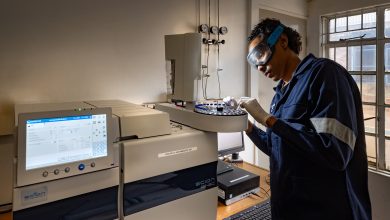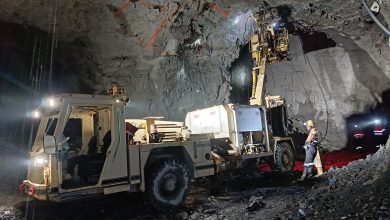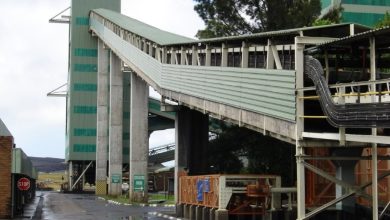
WearCheck ARC’s recent success in keeping a ball mill running is a testament to the invaluable role of precision engineering in modern industry.
The asset reliability care (ARC) division of condition monitoring specialist company, WearCheck, conducts scientific vibration analysis, thermography and a host of related tests to increase the lifespan of machinery and keep it operating at optimum levels.
The comprehensive package of condition monitoring options presents a holistic reliability solution for many industries, including mining, industrial, power generation, transport, shipping, aviation and renewable energy sectors.
The addition of a whole new dimension to traditional predictive maintenance services has transformed WearCheck into a complete one-stop condition monitoring destination, offering a highly sophisticated world-class range of measurements over and above the original oil and fuel analysis services.
The following case study by Annemie Willer, division manager of WearCheck’s ARC division, focuses on how vibration analysis, combined with non-destructive testing and precision maintenance techniques, ensured that a compromised ball mill could continue functioning while waiting on the delivery of spare parts, which have a four month lead time.
Case Study: The installation and continuous operation of a critical ball mill
In the high-stakes world of heavy industrial operations, the successful installation and sustained operation of a compromised ball mill represent a remarkable engineering achievement. WearCheck’s ARC team, leveraging its deep expertise in condition monitoring technologies and non-destructive testing (NDT), played a pivotal role in not just inspecting the mill, but in ensuring that every maintenance action was driven by precise, data-informed decisions. The result: a mill that remains operational despite structural compromises, awaiting critical repairs and long-lead-time spares.
Condition-based approach to installation and operation
From the outset, WearCheck ARC’s approach to this complex challenge was rooted in condition-based maintenance principles. Every step of the installation and commissioning process was guided by insights gathered through advanced condition monitoring techniques. By integrating vibration analysis, precision maintenance, and structural integrity assessments, the team was able to navigate the risks associated with installing and operating a mill on a compromised base.
One of the defining aspects of this project was the use of advanced vibration analysis, both through an online monitoring system and portable diagnostic tools. The Wi-Care 200 system, strategically placed on the Pinion Drive End and Non-Drive End bearings, provides continuous real-time data on critical components that would otherwise be inaccessible. Complementing this, WearCheck ARC’s specialists deployed the Emerson AMS 2140 portable vibration analyser to conduct periodic checks on all accessible components, ensuring a comprehensive assessment of the mill’s dynamic behaviour.
Identifying a Critical Installation Flaw
The ball mill was initially installed by another company after a shaft failure, but it was done without knowledge that the base was compromised. When WearCheck ARC was called in to perform the train alignment, the team immediately noticed excessive shaft movement and base bolts that repeatedly came loose. Suspecting a compromised base, WearCheck ARC initiated further investigations, which were later confirmed by a civil engineer. The mill’s plinth was broken—an issue that had gone unnoticed during the original installation.
This discovery led to a shift in approach—rather than attempting to force a conventional alignment, WearCheck ARC implemented a condition-monitoring-based installation strategy. The team relied on advanced diagnostics, including non-destructive testing (NDT), to assess the structural integrity of key components and determine the correct adjustments for the pinion and girth gear alignment. Despite the fact that the girth gear was already damaged and required replacement, precise adjustments allowed the mill to be aligned and operational while awaiting critical spares.
The greatest challenge in this project was the compromised base of the mill, which introduced significant operational risks. Standard maintenance approaches would not have sufficed—only a combination of in-depth diagnostic techniques and precision maintenance strategies could mitigate these risks effectively. The key findings from the condition monitoring technologies revealed:
- Excessive movement in the mill due to a broken plinth, which compromised its stability.
- Progressive misalignment between the pinion and girth gear, requiring continuous monitoring and adjustments.
- Unavailable critical spares, meaning the mill had to remain operational while awaiting replacements with excessive lead times.
- Cracks in the hub, detected using non-destructive testing, which required replacement to improve reliability.
Despite these challenges, WearCheck ARC’s expertise ensured the mill remained operational without catastrophic failure. By closely tracking vibration trends, structural shifts, and dynamic loads, maintenance actions were timed precisely to intervene before any failure could escalate. The ability to correlate data from both online and portable systems provided a layered approach to asset-health monitoring, creating a level of reliability that conventional inspections could not achieve.
Ensuring stability for continuous operation
Since its installation in October 2024, the mill has been operating continuously for 100 days under stable conditions, thanks to precise interventions based on advanced vibration analysis. However, the risk remains, as critical components -including the pinion and girth gear – have excessive lead times and will not arrive for another four months – approximately in June 2025. Until then, the mill must remain operational through continuous monitoring and precision maintenance.
WearCheck ARC has successfully ensured that production losses have been avoided, proving once again the effectiveness of condition-based maintenance. However, the reality remains—the mill will need to be repaired. In an ideal world, extended shutdowns for comprehensive repairs would be possible, but in heavy industry, that is often not a viable option. This is where the true capability of a condition monitoring company is tested to the ultimate limit.
A legacy of keeping machines running
This is not the first time WearCheck ARC has had to apply its full range of tools and expertise to keep machinery operational while in failure mode. Time and again, the team has ensured that critical equipment remains functional until necessary change-outs or repairs can be performed.
Says Willer, ‘The billions of Rands gained by our clients through production that continued due to this intervention is not what defines WearCheck ARC as experts in the field – that is expected in normal operations. What sets us apart is the fact that in this case, the mill’s operation would not have been possible without the accuracy of our advanced vibration analysis, combined with in-depth knowledge of best maintenance practices and actual machine conditions.
‘WearCheck ARC’s role in this project underscores the power of expertise combined with cutting-edge condition monitoring and NDT techniques. The ability to integrate online and portable vibration analysis, non-destructive testing, and precision maintenance practices ensured that an asset on the brink of failure remained not just operational, but stable and predictable.
Conclusion
As industries continue to push the limits of asset reliability, this case serves as a powerful example of how condition-based maintenance is not just a theoretical best practice, but a real-world necessity for mission-critical equipment. WearCheck ARC’s success in keeping this mill running is a testament to the invaluable role of precision engineering in modern industry.






